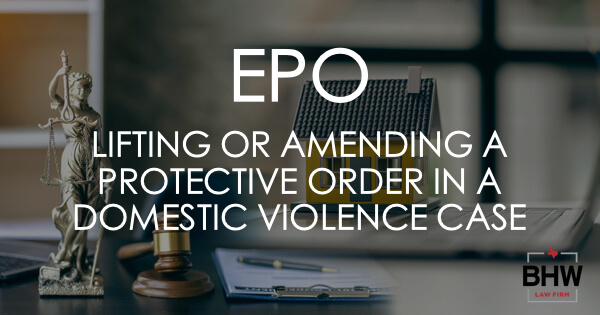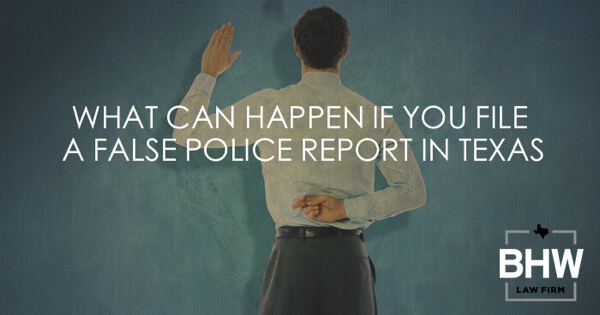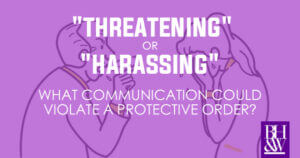
How To Lift an Emergency Protective Order (EPO) Associated with a Texas Domestic Violence Case?

If you were arrested for Assault (Family Violence), chances are that you also received an Emergency Protective Order prohibiting you from going within 500 yards (or similar distance) from the “victim’s” home or workplace, along with other conditions for a period of 31, 61, or 91 days depending on the nature of the alleged assault. Protective Orders can cause big problems, especially when the two parties live together in the same house and share childcare and other family responsibilities.
Can I Lift The Emergency Protective Order So That I Can Go Home?
Yes, you can (in most cases). We are asked this question on a daily basis. A spouse that was arrested for Domestic Violence has been forced to leave the family home because of the EPO. EPOs, however, do not relieve people of their daily responsibilities to take care of children, go to work, or provide for their families. An EPO can certainly throw a wrench into a family dynamic.
We help families modify protective orders to allow a defendant to return home. We do not typically request that the entire EPO be lifted completely, only amended.
Amending an EPO is Not the Same Thing as Lifting an EPO.
So what’s the big difference in lifting an EPO versus amending an EPO. Most judges will not agree to completely lift an EPO, because, as they see it, there was likely a good reason for the imposition of the EPO in the first place. Additionally, in almost every scenario, the District Attorney’s office will oppose lifting the EPO. However, many judges will agree to amend or modify an EPO and change some of the conditions. Usually, if the victim requests it, a judge will amend the protective order to allow the defendant to return home or resume contact with the complainant and the family. However, the remaining conditions, usually involving not committing family violence or threatening the victim, remain in place for the duration of the protective order.
What are the Steps to Amending a Protective Order in Fort Worth?
First, it is important to know that all jurisdictions handle protective orders differently. For instance, the Fort Worth Municipal Court handles protective orders differently from Tarrant County Criminal Court #5. Some courts prefer to hold a formal hearing and others do not. However, in all cases, we request the following:
- An Affidavit from the Victim Requesting a Change of the Protective Order: This can be drafted and signed in our office, but the victim must be present and indicate that this is what he/she wants. In our experience, if the complaining witness does not want the EPO changed, then the judge is not going to change it.
- A Motion to Modify the Protective Order: We draft and file the motion with the court having jurisdiction over the EPO. Texas law requires that we allege 3 things in our motion and that the judge find those 3 things to be true before he/she can modify the EPO:
- (1) The current EPO is unworkable;
- (2) Modification of the EPO will not place the victim in a greater risk of harm; and
- (3) Modification of the EPO will not result in harm to any person protected under the order.
- An Affidavit of Non-Prosecution: This is not a required document, but we allow victims to sign an ANP in our office if they request it. They may end up having to sign another ANP with the prosecutor, but we like to give them the opportunity.
- Formal or Informal Hearing with the Presiding Judge: Some courts will require an actual hearing with witnesses before deciding whether to modify an EPO. Other courts simply prefer the verified documentation and an informal meeting with the state and the defense.
- Filing the Amended Order with the Arresting Agency and Sheriff’s Office: If the judge agrees to amend the protective order, we send a copy of the signed order to the defendant, the complainant, the arresting police agency, and the local sheriff’s office. We also advise our clients to keep a copy of the order near the front door in case a nosy neighbor decides to call the police believing that the EPO is being violated.
I Have an Emergency Protective Order. How Do I Get Started in Amending the Order?
If you have an EPO that was issued against you in response to an allegation of Assault (Family Violence), give us a call today to see if we can assist you in getting the order amended so that you can return home to your family. Every case is different, so we want to speak with you and learn more about your situation. This article will not apply to every case, so call us today at (817) 993-9249. We offer Free Consultations in every case with no obligation.


 As Fort Worth criminal defense attorneys, we are often asked by witnesses and victims what might happen if it comes to light that the story they told the police was not exactly true. We often see this in
As Fort Worth criminal defense attorneys, we are often asked by witnesses and victims what might happen if it comes to light that the story they told the police was not exactly true. We often see this in 
 Family violence stories permeate the news, as domestic violence-related cases continue to fill both Texas criminal and family court dockets alike. The Texas Council On Family Violence reports that one in three Texans will experience domestic violence in their lifetimes. (
Family violence stories permeate the news, as domestic violence-related cases continue to fill both Texas criminal and family court dockets alike. The Texas Council On Family Violence reports that one in three Texans will experience domestic violence in their lifetimes. (
 The Lautenberg Amendment to the Gun Control Act enacted in the Fall of 1996 provides that those with a conviction for a misdemeanor crime of domestic violence cannot use, possess, or transport a firearm or ammunition.
The Lautenberg Amendment to the Gun Control Act enacted in the Fall of 1996 provides that those with a conviction for a misdemeanor crime of domestic violence cannot use, possess, or transport a firearm or ammunition.
 Voisine v. United States
Voisine v. United States
 This week, the Texas Court of Criminal Appeals released Henley v. State. In a 4-3 decision the divided court held that the defendant was not allowed to offer “defense of a third party” as a legal argument in his assault case, because it “was not material to, nor probative of, any fact that was of consequence to the determination of this action.”
This week, the Texas Court of Criminal Appeals released Henley v. State. In a 4-3 decision the divided court held that the defendant was not allowed to offer “defense of a third party” as a legal argument in his assault case, because it “was not material to, nor probative of, any fact that was of consequence to the determination of this action.”
 Most misdemeanor cases in Texas are charged by way of a document called an ”information.” An information does not have to be issued by a grand jury. The information can simply be prepared and reviewed by a District Attorney and then subsequently filed in a court with proper jurisdiction. Felony cases, on the other hand, must be indicted by a grand jury unless a defendant chooses to waive indictment and proceed without one.
Most misdemeanor cases in Texas are charged by way of a document called an ”information.” An information does not have to be issued by a grand jury. The information can simply be prepared and reviewed by a District Attorney and then subsequently filed in a court with proper jurisdiction. Felony cases, on the other hand, must be indicted by a grand jury unless a defendant chooses to waive indictment and proceed without one.
 In Texas, our “failure to protect” statute is an omission statute—Injury to a Child by Omission—meaning it aims to encourage parents to remove their children from dangerous and violent environments. If a parent “fails to protect” their child from certain known dangers, that parent can be charged with Injury to a Child by Omission, a felony level offense in Texas. The statute also covers injury to an elderly or disabled individual. If the person charged with Injury to a Child by Omission is a domestic violence victim, it is important to be aware of the Affirmative Defense Texas provides.
In Texas, our “failure to protect” statute is an omission statute—Injury to a Child by Omission—meaning it aims to encourage parents to remove their children from dangerous and violent environments. If a parent “fails to protect” their child from certain known dangers, that parent can be charged with Injury to a Child by Omission, a felony level offense in Texas. The statute also covers injury to an elderly or disabled individual. If the person charged with Injury to a Child by Omission is a domestic violence victim, it is important to be aware of the Affirmative Defense Texas provides.
 In February 2014, David Schumm and his wife were arguing in their home when she tried to place a 911 call. His wife testified that he prevented her from making the call by taking her cell phone. Fearing an assault, she ran outside, screaming for help. Schumm allegedly followed her outside, dragged her onto their porch and “strangled” her. At trial, Schumm denied all assaultive conduct and denied taking her cell phone. Schumm was charged in two separate cases with Interference with 911 Call and with Assault Family Violence with Impeding Breath. Tex. Penal Code Ann. § 42.062 and § 22.01(b)(2)(B) (West Supp. 2015). Schumm was acquitted of the felony assault charge at trial.
In February 2014, David Schumm and his wife were arguing in their home when she tried to place a 911 call. His wife testified that he prevented her from making the call by taking her cell phone. Fearing an assault, she ran outside, screaming for help. Schumm allegedly followed her outside, dragged her onto their porch and “strangled” her. At trial, Schumm denied all assaultive conduct and denied taking her cell phone. Schumm was charged in two separate cases with Interference with 911 Call and with Assault Family Violence with Impeding Breath. Tex. Penal Code Ann. § 42.062 and § 22.01(b)(2)(B) (West Supp. 2015). Schumm was acquitted of the felony assault charge at trial.





